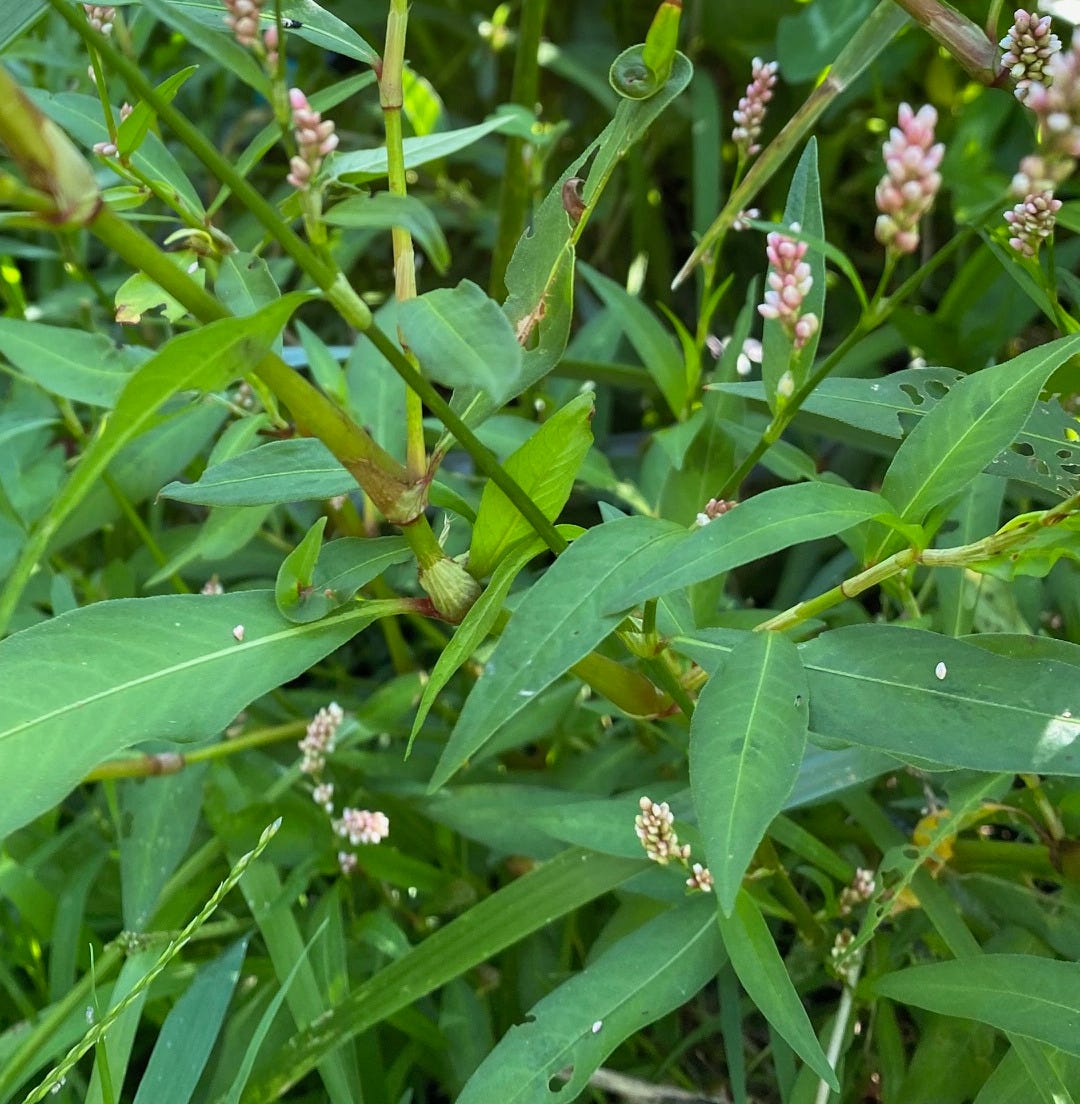Smartweed
spicy 1 - 5
Smartweed serves as food or spice, depending on which species you select. Different species offer varying amounts of heat, and this determines how or where you apply them, and how much of each you can eat.
At weedom we have spicy number 1, Persicaria maculosa, lady’s thumb, which grew profusely along our wood shelter until our second year of drought dried it up, and we decided to cut down most of it. (Not to worry, it’s growing back already). It seems that we have a bit of Persicaria longiseta, Oriental lady’s thumb too. Both of these are non-native to Midwest U.S. flyover country. We can’t stop these invasive weeds unless we get into some serious eating. Our smartweed (leaves and young tips of plants) can be grazed raw or cooked as a spinach replacement. Nutty flavored seeds are also edible, as are the flowers, which are not super tasty. Down in the Florida territory of forager Green Deane Jordan, there are some hot smartweeds which favor wetlands, and which he recommends only as a spice. It seems that he’s dealing with very different species, Persicaria hydropiper and Persicaria punctatum, and they might rate as spicy number 5 or so. People can be fooled by the leaves of these plants as the spice doesn’t hit the taste buds immediately. It takes about 20 seconds for the heat to build, which calls to mind Carribean jerk seasoning. This delayed effect applies even to our own mild smartweed. So when you’re sampling your local smartweed species, start with small amounts, and see how much the flavor builds. The various and sundry people occupying the U.S. tolerate different amounts of hot and spicy.
This brings us to the common nomenclature of smartweed, which possibly gained this moniker based on what happened when people handled the hotter weeds, and then touched some mucous membrane such as eyes, nose or the nether regions. The name has nothing to do with possible nootropic, or brain protective properties but rather more to do with the other end.
Smartweed’s other common name is arsesmart, which was perhaps earned when people ate water pepper and experienced the burn 24 hours later as the food exited from the lower gut. A second theory comes from the folk use of this herb in bedding to deter insects, and perhaps some of it got lost in the largest crack of the body, causing prolonged wakefulness. Last of all, some species of this astringent weed are traditionally used topically to alleviate hemorrhoids. If a hotter species is applied, that’s the most compelling reason for the arse to smart, and historically, P. hydropiper, the hot one, was actually employed for this purpose.
Smartweed, particularly the milder types that can be eaten in quantity, are a good source of minerals such as calcium and magnesium, phosphorus, potassium and iron. It’s a considerable contributor of vitamin K. Nutrition is less a factor for the hot tasting species that are used in spice quantities. Young leaves and tips of the plants are most suitable for eating, though our P. maculosa has palatable leaves even when the plant is flowering.
In the western world, Persicaria hydropiper, water pepper, seems to have the most extensive history of medicinal application in Europe and even in the Americas, where it had spread. This astringent herb constricts the arteries, increases the force of the heart beat, and can increase blood pressure. It has diuretic action, and was historically applied to treat ‘gravel’ and kidney stones. The tannins in this herb contribute to an astringent effect. Cold water infusion of the fresh leaves was used to address mouth sores. It was used in various ways to treat dysentery, diarrhea, flatulent colic, and topically to treat hemorrhoids. This stimulating herb addressed both amenorrhea and excessive menstruation. If you’re short on wasabi, you can substitute water pepper in your Japanese inspired cuisine. The Forager Chef has a quick recipe for a sauce that can be made with a half cup of the leaves and seeds, some toasted sesame, rice vinegar maple syrup and a little salt.
Our own P. maculosa, lady’s thumb, has been used topically on poison ivy rash, used as a poultice for pain, a soak for rheumatism, and applied to horses to keep flies away. It has been taken internally for urinary tract issues, heart troubles, and stomach pain.
Continued drought has imposed a challenge for obtaining decent specimens for the cams of weedom, but we soldier on.
The buckwheat family, Polygonaceae, is comprised of 48 genera, including the Rumex (dock) genus, knotweed genus Polygonum, and the smartweeds which were recently split off into the genus Persicaria. 1200 species of the Polygonaceae exist worldwide and there are about 400 species in the U.S.. This family of plants is characterized by the swollen leaf nodes on the stems which resemble joints, from which the name Polygonaceae (many joints) is derived. Many species have a membranous ocrea covering each of these joints. Check our Yellow Dock and Sheep Sorrel articles for some other useful weeds of the buckwheat family, which display the characteristic joints on their flowering stems. The Persicaria, smartweed genus itself is made up of about 100 species which are concentrated in USDA hardiness zones 2 through 10.
Faint dark spots remain on the leaves of the flowering specimen of Lady’s thumb, below. In our area, this plant reaches about 2 feet (0.6 meter), but others report that it can grow taller. The growth habit of the P. longiseta is similar. Some Persicaria species, such as the imported P. orientalis, with it’s longer, more feathery, blooming racemes, achieve up to 8 feet in height. Its other names are shui hong hua, or prince’s feather, and kiss-me-over-the-garden-gate, says ethnobotanical expert, Richo Cech. Its seeds and dried roots have a place in traditional chinese medicine as a digestive aid and to address metabolic and hepatic disease.
Usually the spots on young leaves of our Lady’s thumb are prominent and somewhat V shaped, and become smaller as the plant matures. This distinguishes this P. maculosa from the P. longiseta which lacks the leaf spots, and has longer bristles on the sheaths that wrap around the nodes of the stems. The sheaths of another similar species, P. pensylvanica have extremely short to no bristles at all, and usually no spots on the leaves.

Tiny 1/8th inch (0.3 cm) flowers of our smartweed species usually have 5-6 tepals, 6 stamens, and a female structure with 2-3 style branches. The pink, or possibly white flowers are gathered in bunches on cylindrical racemes that are usually about an inch long, but may be shorter.
Each flower produces a small flattened achene, or seed which is edible, to humans as well as many species of birds which depend on it. Highly motivated folks can grind the seeds into flour for baking. At weedom we have much seedier weeds and trees than this one, so we haven’t gone to smartweed flour production yet, and are leaving them for the wildlife.
Compared to Persicaria species originating in Asia and Europe, the American native species are poorly studied with respect to medicinal value, though North Americans have been grazing on them for centuries. As expected, the imported P. chinensis and P. hydropiper are among the most well studied and medicinally active. While the young leaves and tips of P. chinensis can be eaten in quantity, the seeds and roots have potent medicinal value.
Water pepper, P. hydropiper, leaves are generally consumed in spice quantity, rather than food quantity, but are valued medicinally for gastroprotective effects, and for treatment of intestinal parasites. The pungency of this herb, which adds heat but doesn’t otherwise affect the flavor of foods, is caused by a sesquiterpine molecule called polygodial. This compound protects the plant as an antifungal and antifeedant, and shows additional anti-allergic, anti-inflammatory effects which are of medicinal value. It’s also directly credited with vasoconstrictive properties which inspired the use of this plant to stop bleeding and to treat hemorrhoids. A body of in vitro studies have also revealed anti-bacterial and antiviral properties of this water pepper, as well as both of the species noted at weedom, and supporting many of it’s other folk uses. Phytoestrogens found in the roots of water pepper have demonstrated antifertility effects in rats, inspiring a “do not use while pregnant” warning.
Most everyone in the world has some kind of edible smartweed growing nearby, can investigate it, and do a taste test of the leaves to evaluate it for food use. It seems that the plants which prefer the wettest soil tend to be hotter. Cooking does dissipate some of the heat, so remember to add it last if you want the most possible spicyness. The milder species such as ours can go directly into the omelets, soups, stir fry and salads. Some people steep the plants and drink the tea. Consider using the plant earlier in the day if you notice its diuretic effects waking you up at night. Check here for a cheat sheet which shows some Persicaria species that aren’t growing in our region.
What are you doing with your smartweeds?
Where We Dig
1. Wild Heat: Wild Horseradish & Arsesmart (Persicaria Hydropiper). HUNTER-GATHERING: wild & fresh food. Accessed September 17, 2024. https://huntergathercook.typepad.com/huntergathering_wild_fres/2013/08/wild-heat-wild-horseradish-arsesmart-persicaria-hydropiper.html
2. Wood M. The Earthwise Herbal - A Complete Guide to Old World Medicinal Plants. North Atlantic Books; 2008. https://openlibrary.org/books/OL12031143M/The_Earthwise_Herbal
3. Deane G. Smartweed: Nature’s Pepper and Pharmacy. Eat The Weeds and other things, too. October 10, 2017. Accessed September 16, 2024. https://www.eattheweeds.com/smartweed-natures-pepper-and-pharmacy/
4. Thayer S. Sam Thayer’s Field Guide to Edible Wild Plants of Eastern & Central North America. Forager’s Harvest; 2023.
5. Persicaria pensylvanica (Pennsylvania Smartweed, Pink Knotweed, Pink Smartweed) | North Carolina Extension Gardener Plant Toolbox. Accessed September 17, 2024. https://plants.ces.ncsu.edu/plants/persicaria-pensylvanica/
6. Persicaria maculosa (lady’s-thumb smartweed): Go Botany. Accessed September 17, 2024. https://gobotany.nativeplanttrust.org/species/persicaria/maculosa/
7. Persicaria longiseta (Oriental lady’s-thumb smartweed): Go Botany. Accessed September 17, 2024. https://gobotany.nativeplanttrust.org/species/persicaria/longiseta/
8. Persicaria Hydropiper - an overview | ScienceDirect Topics. Accessed September 19, 2024. https://www.sciencedirect.com/topics/agricultural-and-biological-sciences/persicaria-hydropiper
9. Grieve M. Modern Herbal. Echo Point Books & Media, LLC.; 2015. https://openlibrary.org/books/OL36722889M/Modern_Herbal
10. Harris H. Lady’s Thumb: Foraging, Safety and Uses. The Homesteading Hippy. February 2, 2022. Accessed September 17, 2024. https://thehomesteadinghippy.com/ladys-thumb/
11. Bergo A. Japanese Style Water Pepper Sauce (Tade Su). Forager | Chef. October 2, 2018. Accessed September 17, 2024. https://foragerchef.com/japanese-style-waterpepper-sauce-tade-su-with-hickory-nut-oil/
12. Hutchens AR. Indian Herbalogy of North America. Shambhala; Distributed in the United States by Random House; 1991. https://openlibrary.org/books/OL1567124M/Indian_herbalogy_of_North_America
13. Nagi KI, Roy B, Yadav AK. In vitro cestocidal activity of Persicaria hydropiper (L.) Delarbre, a traditionally used anthelmintic plant in India. J Parasit Dis. 2023;47(1):198-202. doi:10.1007/s12639-022-01559-2
14. Cech R. Growing Plant Medicine. Vol 2. Herbal Reeds, LLC; 2024.
15. Foraging Lady’s Thumb (Persicaria maculosa and other Persicaria). Practical Self Reliance. June 12, 2024. Accessed September 17, 2024. https://practicalselfreliance.com/ladys-thumb-persicaria-sp/
16. Huq AKMM, Jamal JA, Stanslas J. Ethnobotanical, Phytochemical, Pharmacological, and Toxicological Aspects of Persicaria hydropiper (L.) Delarbre. Evid Based Complement Alternat Med. 2014;2014:782830. doi:10.1155/2014/782830
17. Jordan D. Eat the Weeds: A Forager’s Guide to Identifying and Harvesting 274 Wild Foods. Adventure Publications; 2023.
18. Consortium of Midwest Herbaria - Persicaria pensylvanica. Accessed September 17, 2024. https://midwestherbaria.org/portal/taxa/index.php?taxon=Persicaria+pensylvanica&formsubmit=Search+Terms
19. Consortium of Midwest Herbaria - Persicaria maculosa. Accessed September 17, 2024. https://midwestherbaria.org/portal/taxa/index.php?taxon=67187&clid=5494
20. Consortium of Midwest Herbaria - Persicaria longiseta. Accessed September 17, 2024. https://midwestherbaria.org/portal/taxa/index.php?taxon=Persicaria+longiseta&formsubmit=Search+Terms
21. Seimandi G, Álvarez N, Stegmayer MI, et al. An Update on Phytochemicals and Pharmacological Activities of the Genus Persicaria and Polygonum. Molecules. 2021;26(19):5956. doi:10.3390/molecules26195956







🙃🙃🙃🤗🤗🤗🥰🥰🥰
Oh--so that's smartweed! I've always wondered what that plant with the pink bits was. Not sure if they're flowers or seeds or what--